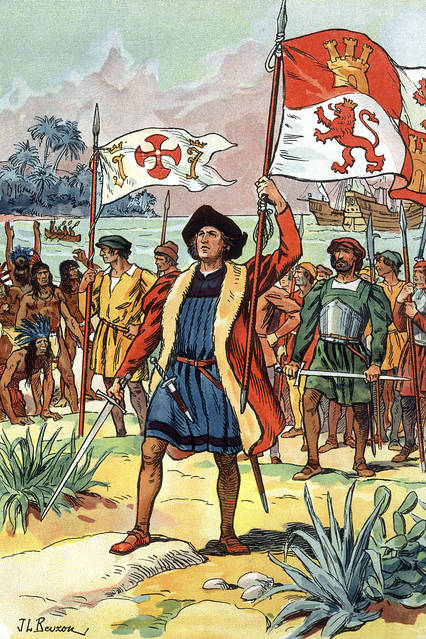Genoese navigator and explorer, most renowned for his voyage to the Americas on October 12, 1492, Christopher Columbus (Cristóbal Colón) ranks among the most important actors in the early modern era. His encounter with the Americas ranks among the most consequential events in world history, placing Old World and New into sustained contact with repercussions that are still being felt today.
Sometimes erroneously credited with the notion that the Earth was spherical and that sailing west would permit reaching the Far East, Columbus was but one of many European navigators in the late 1400s to hold such views.
His fame is not based on his pursuit of an original idea, but on his dogged determination, despite many setbacks, to achieve his goals, combined with the striking good fortune to be the first to reach the Americas and return with evidence of a world that hitherto had lain beyond the ken of Europe.
  |
As a youth Columbus followed his father’s trade and worked as a weaver, also spending some of his time at sea. In 1475, in his early 20s, he journeyed to the eastern Mediterranean. The following year he arrived in England.
Settling in Lisbon in 1477, he married and became enmeshed in the heady world of Portuguese navigators, who at that time were in the forefront of European efforts to reach India and China by sea and thus skirt the Muslim-dominated lands of the Middle East.
Adopting the conviction, widespread among experienced navigators, that uncharted lands lay west across the sea, Columbus for several years tried and failed to secure the patronage of King João II of Portugal for his exploratory venture.
Rebuffed in Lisbon, Columbus took his scheme to the court at Castile, the largest and most powerful of the Spanish Christian kingdoms, and at that time in the final stages of expelling the Moors from Iberia. After eight years, his persistence finally paid off, when Ferdinand V and Isabella I of Spain, flush with their victory over the Moors in Granada, agreed to patronize the scheme of the Genoese navigator.
Setting sail from Palos, Spain, on August 3, 1492, Columbus commanded three small caravels: the Santa María, which he himself captained; the Pinta under experienced navigator Martín Alonso Pinzón; and the Niña under Vicente Yáñez Pinzón.
After replenishing supplies in the Canary Islands, the convoy headed due west from September 6 to October 7, changing course to southwest at the suggestion of Martín Pinzón. Quelling a small mutiny on October 10, Columbus and his convoy sighted land on October 12, probably Watling Island in the Bahamas.
 |
| Landing of Christopher Columbus |
Erecting a cross, planting a flag, and claiming the land for Spain, Columbus christened the island San Salvador. He also interrogated the natives about the source of the gold ornaments they were wearing. As in subsequent expeditions, gold was paramount in the litany of marketable commodities from which Columbus and his subordinates were seeking to profit.
After exploring and charting neighboring islands, on October 27, the convoy sighted Cuba, and on December 5, Hispaniola. Earlier, in late November, in an act of insubordination, Martín Pinzón took the Pinta east in search of the island of Babeque, reputed to be a source of gold.
Columbus did not see Pinzón again until January 6, 1493, when they reunited on the north coast of Hispaniola. On December 20, the Santa María and Niña sailed into Acul Bay on the north coast of Hispaniola. On December 24, in the midst of Christmas Eve celebrations, the Santa María drifted onto a coral reef and was destroyed.
   |
Interpreting the wreck as a sign from God, Columbus used what remained of the Santa María to create the rudiments of the first European settlement in the New World, which he called Villa de la Navidad (Christmas Village).
Leaving some 40 men behind at Navidad, Columbus linked up with the Pinta under Pinzón, and together they continued exploring the north coast of Hispaniola. On January 15, 1493, Columbus decided to return to Spain. After a brief and unexpected stop in Lisbon, he, Pinzón, their crews, and six native Taínos sailed into Palos, Spain, on March 15.
Received at the court with great pomp and majesty, Columbus was granted a coat of arms and other high honors, including being named Admiral of the Ocean Sea as stipulated in his contract. Less than two months later, on April 29, his letter to King Ferdinand and Queen Isabella describing his discoveries was published in Italy, and within the year was circulating widely throughout Europe.
The overall effect was electrifying and distinguishes Columbus’s voyage from others who may have reached the Americas before him. Its political impact was also immediate and profound, ratcheting up the competition between Spain and Portugal in particular.
Fortunately for Spain, Pope Alexander VI declared Spain’s right to claim all new lands west of a north-south line 100 leagues (less than 500 kilometers) west of the Azores, into which all of the Americas fell. In 1494, the line was modified, to the benefit of Portugal, in the Treaty of Tordesillas.
Columbus made three subsequent voyages to the New World in 1493, 1498, and 1502, making many additional discoveries, none of which, however, compared to his first.
During this period, his reputation at the Spanish court declined markedly, as he proved a great explorer and self-promoter but a very poor administrator of the numerous settlements he had founded. Indeed in 1500, the newly appointed governor of Hispaniola sent Columbus back to Spain in chains in consequence of the colony’s dismal conditions.
Until the end of his days, Columbus was convinced that he had reached the East Indies, while the scramble for lands and resources that his discoveries initiated forever transformed the face of Europe, Africa, and the Americas.
